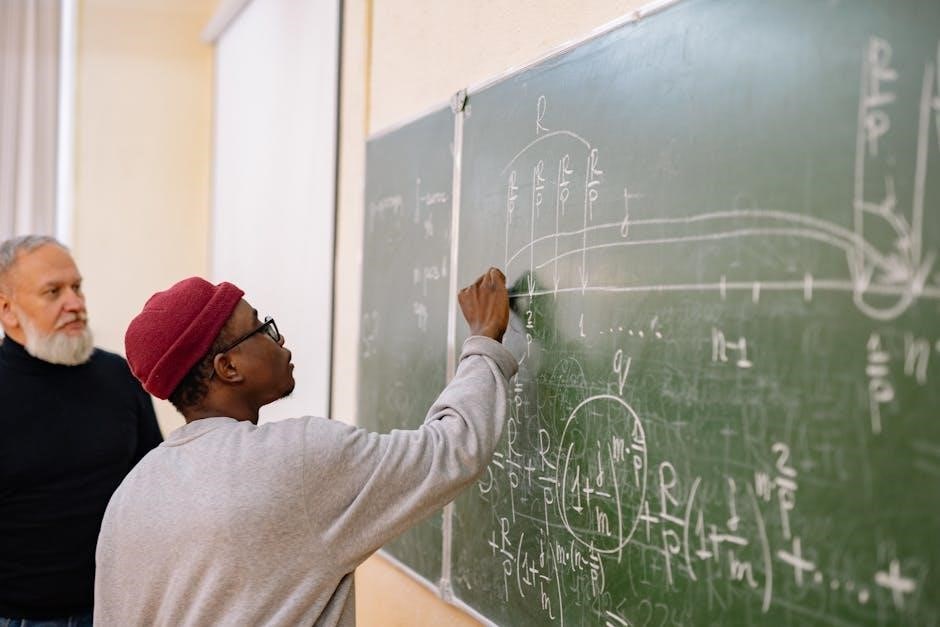
newton’s laws of motion questions and answers pdf
Newton’s Laws of Motion: Practice Problems and Solutions
Explore the world of motion with our curated collection of practice problems and detailed solutions․ Grasp Newton’s laws through real-world scenarios and step-by-step explanations, enhancing your problem-solving skills․ Master the fundamental principles governing motion, force, and inertia with ease and confidence․
Newton’s First Law: Inertia Explained
Delve into Newton’s First Law, also known as the Law of Inertia, which states that an object at rest stays at rest, and an object in motion stays in motion with the same speed and direction unless acted upon by a force․ Understand how inertia dictates an object’s resistance to changes in its state of motion․ Explore real-world examples demonstrating inertia in action, from a stationary car to a hockey puck gliding across the ice․ Grasp the concept of equilibrium, where the net force acting on an object is zero, resulting in no acceleration․ Discover how inertia plays a crucial role in everyday phenomena and scientific applications․ Learn to identify inertial frames of reference and understand their significance in describing motion․ Explore the relationship between mass and inertia, recognizing that more massive objects possess greater inertia․ Uncover the implications of inertia for safety, such as the importance of seatbelts in preventing injury during sudden stops․
Understanding Newton’s Second Law: F=ma
Unravel the essence of Newton’s Second Law of Motion, which mathematically expresses the relationship between force, mass, and acceleration as F=ma․ Discover how this fundamental equation quantifies the effect of force on an object’s motion․ Explore the concepts of net force and resultant force, understanding that acceleration is directly proportional to the net force acting on an object and inversely proportional to its mass․ Delve into the units of force, mass, and acceleration, ensuring a clear understanding of their measurement․ Examine various scenarios where Newton’s Second Law can be applied to calculate forces, masses, or accelerations in linear motion․ Learn how to handle vector quantities in force calculations, considering both magnitude and direction․ Discover how Newton’s Second Law can be used to analyze the motion of objects under the influence of multiple forces․ Explore the relationship between weight and mass, understanding that weight is the force exerted on an object due to gravity․ Consider the effects of friction and air resistance on the motion of objects, recognizing how these forces influence acceleration․
Applying Newton’s Second Law: Practice Problems
Enhance your comprehension of Newton’s Second Law through a series of practical exercises designed to reinforce your understanding of F=ma․ These problems are crafted to challenge your ability to apply the law in diverse scenarios, ranging from simple linear motion to more complex situations involving multiple forces․ Each problem provides an opportunity to calculate force, mass, or acceleration given the other two variables․ Work through examples involving objects moving horizontally, vertically, and on inclined planes, considering the effects of gravity and friction․ Develop your skills in resolving forces into components to analyze motion in two dimensions․ Explore problems where you need to calculate the net force acting on an object before determining its acceleration․ Practice identifying and applying appropriate units for force (Newtons), mass (kilograms), and acceleration (meters per second squared)․ These practice problems will help you connect theoretical concepts to real-world applications, ensuring a solid grasp of Newton’s Second Law․ By working through these exercises, you’ll gain confidence in your ability to solve a wide range of physics problems related to motion and forces, making you a proficient problem solver․
Newton’s Third Law: Action and Reaction
Delve into the intricacies of Newton’s Third Law, which states that for every action, there is an equal and opposite reaction․ Understand that forces always occur in pairs, acting on different objects․ Explore how these action-reaction pairs are fundamental to understanding interactions between objects․ Examine examples such as a book resting on a table, where the book exerts a downward force (action) and the table exerts an equal upward force (reaction)․ Analyze scenarios involving collisions, where the force exerted by one object on another is met with an equal and opposite force․ Consider rocket propulsion, where the expulsion of exhaust gases (action) results in the rocket moving forward (reaction)․ Grasp the importance of identifying the two objects involved in each action-reaction pair․ Learn to distinguish between internal and external forces within a system․ Realize that action-reaction forces, though equal in magnitude and opposite in direction, do not cancel each other out because they act on different objects․ Explore everyday examples like walking, swimming, and pushing against a wall to solidify your understanding of this vital law of physics․ This foundational law provides key insights into force interactions․
Identifying Action-Reaction Pairs
Master the skill of pinpointing action-reaction pairs, a crucial aspect of understanding Newton’s Third Law․ Learn to recognize that these pairs always involve two distinct objects․ Understand that the action force and the reaction force are equal in magnitude but opposite in direction․ Practice identifying the agent and the recipient of each force within a pair․ For instance, in the scenario of a baseball being hit by a bat, the bat exerts a force on the ball (action), and simultaneously, the ball exerts an equal and opposite force on the bat (reaction)․ Consider a person walking; they exert a backward force on the ground (action), and the ground exerts an equal forward force on the person (reaction), propelling them forward․ Analyze examples where the forces might seem unbalanced, such as a small car colliding with a large truck; despite the differing outcomes, the forces between the car and truck are still equal and opposite․ Avoid common misconceptions, such as confusing action-reaction pairs with balanced forces acting on the same object․ Remember that action-reaction forces never act on the same object․ Practice with various scenarios, including objects at rest, objects in motion, and interacting systems, to sharpen your ability to accurately identify these fundamental force pairs and deepen your grasp of Newton’s Third Law․
Net Force Calculations: Combining Forces
Understanding net force is crucial for applying Newton’s Laws effectively․ The net force represents the vector sum of all individual forces acting on an object․ To calculate net force, you must consider both the magnitude and direction of each force․ Forces acting in the same direction are added together, while forces acting in opposite directions are subtracted․ When forces act at angles, vector components must be used to find the resultant force in each dimension (x and y)․ The Pythagorean theorem can then be used to determine the magnitude of the net force, and trigonometry can be used to find its direction․ For example, if an object experiences a 10N force to the right and a 5N force to the left, the net force is 5N to the right․ If an object experiences a 10N force upwards and a 10N force to the right, the net force is approximately 14․14N at a 45-degree angle․ Practice problems involving various scenarios will help you master the art of combining forces․ These scenarios could include friction, gravity, applied forces, and tension․ Be sure to draw free-body diagrams to visually represent the forces acting on the object, making it easier to determine the net force and apply Newton’s Second Law (F=ma)․
Free-Body Diagrams: Visualizing Forces
Free-body diagrams are essential tools for visualizing and analyzing forces acting on an object․ A free-body diagram is a simplified representation of an object, showing all the forces acting on it as vectors․ The object is typically represented as a simple box or point, and each force is drawn as an arrow originating from the object, indicating its magnitude and direction․ Common forces include weight (gravity), normal force (support), tension (from ropes), friction (opposing motion), and applied forces․ When drawing a free-body diagram, it’s crucial to identify all the forces acting on the object and represent them accurately․ The length of the arrow should be proportional to the magnitude of the force, and the angle should represent the direction of the force relative to a chosen coordinate system․ Using free-body diagrams helps to simplify complex problems by isolating the forces acting on the object of interest․ Once the diagram is complete, you can apply Newton’s Laws to analyze the motion of the object․ For example, the sum of the forces in each direction (x and y) can be set equal to mass times acceleration (F=ma), allowing you to solve for unknown variables such as acceleration, force, or mass․ By mastering free-body diagrams, you can greatly enhance your ability to solve a wide range of mechanics problems․
Problem-Solving Strategies: A Step-by-Step Approach

Solving problems involving Newton’s Laws requires a systematic approach․ First, read the problem carefully, identifying what you’re trying to find (the unknown) and what information is given (the knowns)․ Draw a diagram of the situation, including all relevant objects and forces․ Next, create a free-body diagram for each object of interest, showing all the forces acting on it․ Choose a convenient coordinate system (x-y axes) and resolve forces into their components along these axes․ Apply Newton’s Second Law (F=ma) to each object, writing equations for the sum of forces in both the x and y directions․ This will give you a system of equations․ Solve these equations simultaneously to find the unknown variables․ Ensure that your units are consistent throughout the problem․ Once you have a solution, check if it makes sense physically․ Does the magnitude of the answer seem reasonable? Does the direction match your expectations? Finally, review your work to ensure accuracy․ By following these steps, you can tackle even complex problems involving Newton’s Laws with confidence and precision․ Remember, practice makes perfect, so work through a variety of examples to improve your problem-solving skills․

Mass vs․ Weight: Key Differences
Mass and weight, while often used interchangeably in everyday language, are fundamentally different concepts in physics․ Mass is a measure of the amount of matter in an object, a scalar quantity indicating its resistance to acceleration․ It remains constant regardless of location․ The standard unit of mass is the kilogram (kg)․ Weight, on the other hand, is the force exerted on an object due to gravity․ It’s a vector quantity, having both magnitude and direction (downward, towards the center of the Earth or other celestial body)․ Weight is calculated as W = mg, where ‘m’ is mass and ‘g’ is the acceleration due to gravity (approximately 9․8 m/s² on Earth’s surface)․ The unit of weight is the Newton (N)․ Because ‘g’ varies slightly depending on location (altitude, latitude, and the presence of large masses nearby), an object’s weight can change, even though its mass remains constant․ For instance, an object weighs less on the Moon (lower ‘g’) than on Earth․ Understanding this distinction is crucial for correctly applying Newton’s Laws and solving related problems․ Confusing mass and weight can lead to significant errors in calculations and interpretations․
Real-World Applications of Newton’s Laws
Newton’s Laws of Motion are not merely theoretical concepts; they are fundamental principles that govern countless phenomena in our daily lives․ Consider the simple act of walking: Newton’s Third Law explains how we propel ourselves forward – our feet push backward on the ground, and the ground, in turn, pushes us forward with an equal and opposite force․ Driving a car relies heavily on these laws․ Acceleration, braking, and turning all involve forces described by Newton’s Second Law (F=ma)․ Seatbelts are designed to counteract inertia (Newton’s First Law), preventing passengers from continuing their forward motion in a sudden stop․ In sports, understanding these laws is crucial for optimizing performance․ A baseball player applies force to a ball to accelerate it, a swimmer pushes against the water, and a cyclist overcomes air resistance – all governed by Newton’s Laws․ Even seemingly complex systems like rockets and airplanes rely on these principles for propulsion and lift․ Engineers use these laws to design structures, machines, and vehicles, ensuring stability, efficiency, and safety․ From the smallest everyday actions to the most advanced technological achievements, Newton’s Laws are constantly at play, shaping the world around us․
Practice Problems: Solving for Acceleration
Sharpen your understanding of Newton’s Second Law (F=ma) by tackling these practice problems focused on solving for acceleration․ Each problem presents a unique scenario where you’ll need to apply your knowledge of force and mass to determine the resulting acceleration․ Remember, acceleration is the rate of change of velocity, and it’s directly proportional to the net force acting on an object and inversely proportional to its mass․ Carefully analyze each problem, identify the known quantities (force and mass), and use the formula a = F/m to calculate the acceleration․ Pay close attention to units – ensure force is in Newtons (N), mass is in kilograms (kg), and acceleration will then be in meters per second squared (m/s²)․ Some problems may involve multiple forces acting on the object; in such cases, you’ll need to calculate the net force first before applying Newton’s Second Law․ Consider the direction of the forces and use appropriate signs (+ or -) to represent them․ By working through these problems, you’ll develop a strong foundation in applying Newton’s Second Law to solve for acceleration in various real-world situations․ Don’t hesitate to draw free-body diagrams to visualize the forces acting on the object – this can often simplify the problem-solving process․

Practice Problems: Solving for Force and Mass
Enhance your grasp of Newton’s Second Law with these targeted practice problems, focusing on calculating force and mass․ These problems will challenge you to rearrange the fundamental equation, F=ma, to solve for either force (F = ma) or mass (m = F/a)․ Carefully examine each scenario, identifying the given values for acceleration and either force or mass․ When solving for force, ensure you have the mass in kilograms (kg) and acceleration in meters per second squared (m/s²) to obtain the force in Newtons (N)․ Conversely, when solving for mass, confirm the force is in Newtons and acceleration is in m/s²․ Remember, the direction of the force is crucial; consider using free-body diagrams to visualize the forces involved and their directions․ Some problems may require you to first calculate the acceleration from kinematic equations before applying Newton’s Second Law․ Pay close attention to the units and ensure consistency throughout your calculations․ These practice problems will strengthen your ability to apply Newton’s Second Law in various contexts, enabling you to confidently solve for force and mass in diverse physical situations․ By mastering these calculations, you’ll gain a deeper understanding of the relationship between force, mass, and acceleration․


